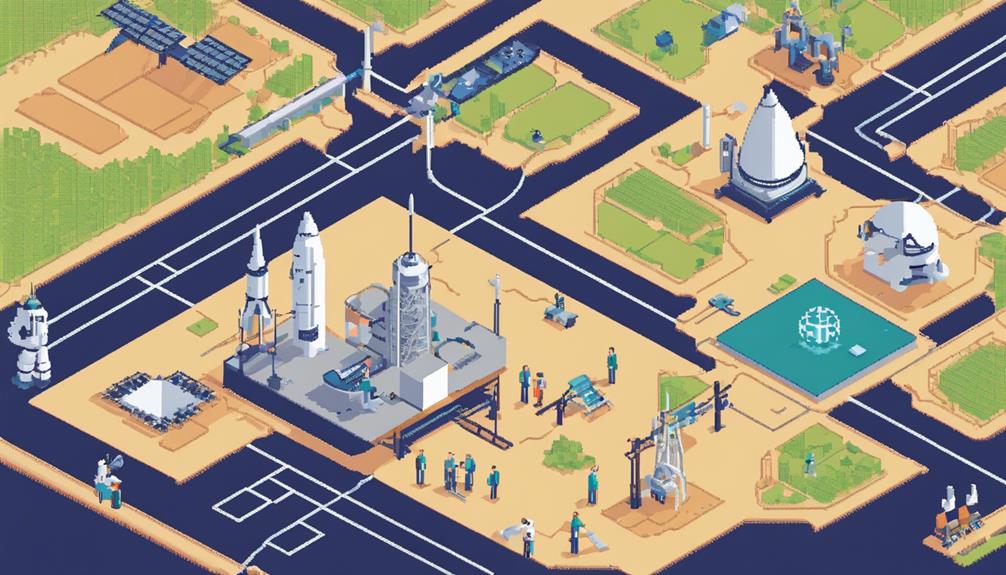The adherence to stringent environmental regulations for satellite launches is paramount in safeguarding our planet's ecosystem. With the increasing number of satellites being deployed into orbit, concerns have been raised regarding the long-term environmental implications of these activities. As stakeholders advocate for greater transparency and accountability in assessing the environmental impacts of large satellite constellations, the need for robust regulatory frameworks and proactive measures becomes ever more pressing. Exploring the intricate balance between technological advancement and environmental preservation in the realm of satellite launches reveals a complex landscape that demands meticulous attention.
Key Takeaways
- Compliance monitoring is crucial for assessing environmental impacts during satellite launches.
- Environmental Impact Assessments identify risks like pollution and habitat disruption.
- Mitigation measures focus on reducing hazardous debris generation and ensuring sustainability.
- International cooperation establishes shared standards for sustainable satellite launch practices.
Regulatory Framework for Satellite Launches

The regulatory framework governing satellite launches is a comprehensive system of guidelines and procedures designed to ensure compliance with environmental regulations and mitigate potential impacts on the ecosystem and surrounding habitats. Key components of this framework include the National Environmental Policy Act (NEPA), which mandates that federal agencies assess the environmental impacts of major actions, such as satellite launches. The Federal Communications Commission (FCC) plays a crucial role in this process by reviewing satellite launch proposals for potential environmental effects, including concerns such as sunlight reflections, orbital debris, and launch emissions.
One significant aspect of the regulatory framework is the FCC's categorical exclusion for satellite constellations. However, concerns have been raised regarding the adequacy of documentation and periodic review to guarantee compliance with NEPA regulations. Transparent and up-to-date decisions are vital when licensing large satellite constellations to effectively address environmental effects. As the number of satellites in orbit continues to rise, stakeholders emphasize the importance of federal agencies giving due consideration to environmental impacts. Ensuring that environmental impact statements are thorough and that NEPA regulations are strictly adhered to is essential in managing the environmental effects of satellite launches and the operation of satellite constellations.
Environmental Impact Assessments
Environmental Impact Assessments play a crucial role in evaluating and addressing potential environmental effects resulting from satellite launch activities.
- Comprehensive Evaluation: Environmental Impact Assessments for satellite launches involve a thorough evaluation of the potential environmental impact of the launch activities. This includes assessing factors such as emissions, debris generation, and the overall impact on ecosystems.
- Risk Identification: These assessments help in identifying potential risks to the environment that may arise from satellite launches. This includes risks such as pollution, contamination of water and soil, as well as disruption to habitats and biodiversity.
- Environmental Responsibility: By conducting these assessments, satellite launch operators can ensure that their activities are carried out in an environmentally responsible manner. This is essential for minimizing negative impacts on the environment.
- Informed Decision-making: Data gathered through Environmental Impact Assessments informs decision-making processes regarding satellite launches. This data is crucial for implementing mitigation measures to reduce or eliminate any identified negative environmental impacts.
Mitigation Measures for Launch Activities

In the realm of satellite launches, the implementation of mitigation measures is paramount to address the risks associated with hazardous debris generation and to ensure the sustainability of space activities. Launch activities have the potential to generate space debris, necessitating robust mitigation measures to minimize contamination risks. Guidelines advocate for the reduction of debris through the use of reusable components, ensuring safe reentry and disposal, and monitoring debris using radar and optical instruments.
Mitigation efforts focus on minimizing the generation of hazardous debris during launches to mitigate potential hazards for both spacecraft and the environment. Ground-based tracking stations play a pivotal role in continuously monitoring debris produced by rocket stages, fairings, and payloads to prevent collisions and contamination risks. These stations are essential for tracking the trajectory of debris and ensuring that it does not pose a threat to operational spacecraft or contribute to the buildup of space debris.
Compliance With Environmental Standards
Mitigation measures for launch activities are integral to ensuring compliance with environmental standards for satellite launches, as mandated by the Federal Communications Commission (FCC) and the National Environmental Policy Act (NEPA). To achieve compliance, the following steps must be taken:
- Assessment of Potential Environmental Impact: Environmental standards for satellite launches encompass a thorough evaluation of potential effects such as sunlight reflections, orbital debris, and launch emissions. Understanding these impacts is essential in developing strategies to mitigate environmental harm.
- Review of Large Satellite Constellations: The FCC bears the responsibility of reviewing and documenting whether the licensing of large constellations of satellites could result in significant environmental effects. This proactive approach ensures that potential risks are identified and addressed prior to launch.
- Compliance Monitoring: Compliance with environmental standards is crucial in mitigating the environmental impact of rocket launches. Regular monitoring and adherence to these standards throughout the launch process are imperative to minimize adverse effects on the environment.
- Transparent Decision-Making: Transparent and current decisions are necessary to ensure that satellite constellations adhere to environmental standards. Transparency in the decision-making process fosters accountability and enables stakeholders to understand the rationale behind environmental regulations, promoting overall compliance.
Monitoring and Enforcement of Regulations

Monitoring and enforcing environmental regulations for satellite launches involves various critical points. These include verifying compliance through methods such as emission tracking and safety assessments, imposing penalties for violations of set limits and standards, and overseeing regulatory responsibilities to ensure adherence to environmental protocols. By focusing on these key aspects, regulatory bodies can effectively monitor and enforce environmental regulations to safeguard the environment and maintain sustainable space operations.
Compliance Verification Methods
Ground-based sensors, satellite observations, and atmospheric models are utilized to ensure compliance with environmental regulations for satellite launches through rigorous monitoring and enforcement methods.
- Utilizing National Environmental Policy Act (NEPA) guidelines: Conducting environmental assessments before rocket launches for commercial satellites to evaluate potential environmental impacts.
- Engaging regulatory agencies: Collaborating with regulatory bodies to ensure compliance with environmental regulations and debris mitigation practices.
- Implementing space environment monitoring: Utilizing advanced technologies like radar and optical instruments to monitor the space environment during satellite launches.
- Verifying compliance with environmental regulations: Employing ground-based tracking stations to ensure adherence to space debris mitigation guidelines and other environmental regulations.
Penalties for Violations
Enforcement mechanisms for environmental regulations governing satellite launches include penalties for violations that are monitored and enforced by regulatory agencies such as the FCC. Penalties for violations, ranging from fines to license revocation, are crucial in ensuring compliance with environmental regulations like the National Environmental Policy Act (NEPA). The severity of the environmental impact caused by a satellite launch often determines the extent of the penalties imposed. Monitoring by federal agencies guarantees that satellite operators adhere to standards outlined in the environmental impact statement. Maintaining environmental sustainability in satellite launches necessitates strict enforcement of regulations to deter non-compliance and mitigate adverse effects on the environment.
| Penalties | Description | Severity |
|---|---|---|
| Fines | Monetary penalties for environmental breaches | Varied based on impact |
| License Revocation | Withdrawal of launch permit due to violations | Severe consequences |
| Compliance | Adherence to NEPA and environmental regulations | Essential for operations |
Regulatory Oversight Responsibilities
Regulatory oversight responsibilities encompass the meticulous monitoring and stringent enforcement of environmental regulations governing satellite launches.
- Monitoring compliance with environmental standards during satellite launches is crucial to assess the impact on the environment.
- Enforcement ensures that satellite companies adhere to regulations set by agencies like the FCC to mitigate adverse effects.
- Activities focus on evaluating emissions and managing debris to minimize environmental consequences.
- Reviewing data on launch emissions, debris generation, and potential environmental effects is integral to overseeing sustainable space activities.
International Cooperation on Environmental Guidelines

International cooperation on environmental guidelines for satellite launches is crucial in establishing shared standards, fostering collaborative policy development, and conducting cross-border impact assessments. By aligning efforts across nations, a unified approach can be achieved to address environmental concerns associated with satellite deployments. This cooperation ensures consistency in environmental practices and aids in the sustainable operation of satellites on a global scale.
Shared Environmental Standards
How do shared environmental standards in satellite launches contribute to global environmental protection efforts? When nations come together to establish categorical and shared environmental guidelines for rocket launches, they create a framework that addresses the potential environmental impact of deploying large constellations of satellites. These global standards, often overseen by organizations like the Federal Aviation Administration, ensure that responsible space activities are conducted with a focus on mitigating environmental effects. By adhering to these guidelines, satellite operators worldwide can work towards minimizing their footprint on the environment and promoting sustainable practices in the aerospace industry. This unified approach helps in safeguarding the planet while fostering innovation and progress in space exploration.
Collaborative Policy Development
Collaborative policy development on environmental guidelines for satellite launches necessitates cohesive international efforts to ensure consistent and sustainable standards across borders. International cooperation plays a crucial role in developing shared guidelines that promote responsible deployment of satellite launches. By engaging in collaborative policy development, countries can address cross-border environmental impacts and work together to establish best practices for minimizing adverse effects on the global environment. Through joint efforts, sustainable practices can be implemented to mitigate the environmental footprint of satellite activities. This coordinated approach not only supports the protection of the environment but also fosters a framework for the conscientious and environmentally friendly deployment of satellites into space.
Cross-Border Impact Assessment
Efforts to assess the cross-border impact of satellite launches on the environment require a comprehensive and collaborative approach among nations.
- International cooperation is essential for evaluating the national and orbital environmental effects of rocket launches.
- Guidelines for cross-border impact assessments help address global concerns associated with satellite constellations.
- Collaborative efforts among countries ensure a thorough examination of the ecological footprint of launch activities.
- Shared frameworks promote transparency and accountability in managing and mitigating the environmental effects of satellite deployments on a global scale.
Future Trends in Satellite Launch Regulations

In anticipation of regulatory developments following the finalization of CEQ rules, the FCC is poised to implement new procedures for satellite launch regulations. With the increasing number of large satellite constellations being launched into orbit, it is crucial for the FCC to ensure that licensing procedures are transparent and up to date with environmental regulations. As part of this effort, the FCC anticipates conducting a review of its National Environmental Policy Act (NEPA) rules and aligning them with any directives outlined in the final CEQ rules for satellite launches.
To maintain a high standard of environmental protection, the FCC should establish a clear timeframe and process for the periodic review of its categorical exclusion under NEPA for satellite launches. Additionally, it is essential for the FCC to identify and publicly disclose the factors that would be considered in determining extraordinary circumstances during the licensing of satellite launches. This transparency is vital for stakeholders to understand the decision-making process and ensure that environmental concerns are adequately addressed in future satellite launch regulations.
Frequently Asked Questions
What Regulatory Approvals Are Needed to Launch a Satellite in Space?
To launch a satellite in space, regulatory approvals such as launch permits and safety protocols are required. These approvals ensure compliance with environmental regulations related to space debris, noise pollution, air quality, wildlife protection, land use, water contamination, waste management, and emission standards. Meeting these criteria is essential to mitigate potential environmental impacts and ensure the sustainability of satellite launches.
Are There Regulations for Satellites?
Regulations for satellites cover a range of aspects such as space debris, launch emissions, orbital pollution, rocket fuel, atmospheric impact, launch sites, noise pollution, space exploration, satellite disposal, and environmental impact. Oversight by agencies like the FCC ensures compliance with environmental standards, safeguarding celestial and terrestrial environments. These regulations are vital to sustainably manage the increasing number of satellite constellations and their impact on Earth's surroundings.
What Are the Environmental Issues With Satellites?
Satellites contribute to environmental issues through various means. Space debris, orbital collisions, and radiofrequency interference are key concerns. Additionally, solar panel waste, rocket emissions, and space junk pose threats. Wildlife impact, atmospheric pollution, and noise pollution are also considerations. Mitigating these impacts is crucial for sustainable space activities and requires robust environmental management strategies. Efforts to address these challenges must be prioritized to ensure the long-term viability of satellite operations.
What Is the Environmental Law in Space?
In the realm of space environmental law, intricate considerations address a myriad of factors. From the management of space debris to the sustainability of space habitats, legal frameworks must navigate complex issues like solar panel waste, resource extraction, and orbital pollution. Regulatory efforts extend to diverse activities such as space tourism, asteroid mining, lunar exploration, and the establishment of space colonies. The evolving legal landscape strives to balance technological advancements with environmental preservation in the vast expanse of space.
